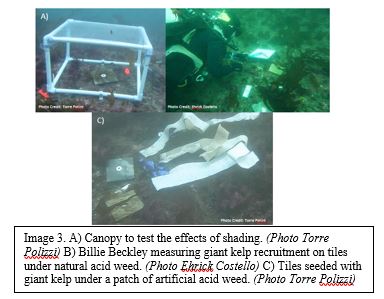Seaweed Wars: Return of the Giant Kelp
A long time ago, in an ocean not so far away, a boat jetted across the calm swell of Point Loma. However, under the surface of the rolling waves a silent battle was raging. Algae just under the surface are locked in a constant fight for light and space. In recent years, foundational giant kelp, Macrocystis pyrifera, has been losing the battle for dominance on rocky temperate reefs. As a result, the giant kelp canopy off the coast of Point Loma, San Diego, California has dwindled. I dedicated my research to understanding exactly how other algae are winning the battle with giant kelp for space on the ocean floor.

Kelp forests are decreasing globally, and this loss is generally attributed to losing the tall canopy-forming species. Along the California coast, giant kelp forests are vanishing in response to a myriad of stressors, most of which are linked to winter storms. The tall giant kelp plants that you can see on the surface are particularly vulnerable to storms and the resulting wave force that rips them from the ocean floor (Image 1). Following this disturbance, these kelp forests look drastically different. Low-lying opportunistic algae take advantage of this increased space and light, dominating the area previously covered with giant kelp. Think about walking through a tall redwood forest one day, and it turning into low-lying grasslands the next. This change in vertical structure has reverberating effects for invertebrates, fish, marine mammals, and humans that depend on these marine forests for both food and shelter. For us humans, giant kelp forests support lucrative fisheries, like California’s spiny lobster fishery, as well as protect our coasts from erosion through wave attenuation.

As a master’s student in Dr. Matthew Edwards’s Kelp Forest Ecology Laboratory at San Diego State University, I investigated how kelp species compete with each other. Specifically, I wanted to understand how smaller low-lying understory algae affect recovery of tall canopy species like giant kelp. In California, dense fields of “acid weed”, Desmarestia herbacea, appear following winter storms that remove the giant kelp canopy. These stands of acid weed can delay giant kelp canopy recovery up to 2 years following the storm! Acid weed is a fascinating alga because it possesses unique characteristics that may play an important role in its ability to affect giant kelp canopy recovery. Acid weed has the potential to affect neighboring algae through: 1) shading and blocking light from the bottom, 2) scouring or physical abrasion of the substrate (like sweeping a broom over a garden), or 3) allelopathy or “chemical warfare” resulting from acid weed’s acidic properties (the internal pH of acid weed is so low that it is similar to battery acid!). Using SCUBA, I out-planted tiny microscopic giant kelp individuals on tiles under treatments that isolated the effects of each mechanism (Image 2). I used shade canopies, artificial acid weed, and natural acid weed individuals (Image 3). Then, I monitored giant kelp recruitment, survival & growth over time.

My research found that different life stages of giant kelp are differentially susceptible to competitive mechanisms. Scouring is most important for giant kelp recruitment (the transition to just visible individuals), while shading and scouring are equally important for giant kelp survival and growth. Overall, this study helps to understand how algae compete with each other. Understanding how different life stages of giant kelp are affected by competition allows us to better predict recovery times for giant kelp following disturbances. It also provides information that can be used to conserve giant kelp and protect vulnerable life stages. As winter storms increase in frequency and intensity, the likelihood for opportunistic species, like acid weed, taking over and preventing giant kelp recovery will rise. This research helps us predict how different opportunistic species will affect the recovery of giant kelp following storms.
The AAUS research scholarship provided the opportunity to complete a diving-intensive research project off of Point Loma, San Diego, California. This project required mastering lots of rewarding

underwater techniques as I like to call “underwater carpentry”. I drilled bolts into the ocean bottom using a pneumatic drill in order to secure the experiment, and I hammered tiles seeded with giant kelp and fake algae to the bottom (Image 4). Most importantly, this project allowed me to mentor and work with undergraduates both in the laboratory and diving in the field. Diving almost daily in the summer months provided an opportunity to observe firsthand the effects of storms on kelp forest resilience, and this sparked excitement to continue to understand changes to our local marine habitat.
So, the next time you are admiring a peaceful view of the ocean, just think about the battles being fought under the surface on the ocean floor. If you see tall giant kelp blades on the surface, know that giant kelp is resisting the imperial march of the acid weed and the resilient giant kelp are seeking to restore balance to the force…in the ocean.
Thank you for awarding me the AAUS research scholarship and supporting my research in the Point Loma kelp forest.
Billie Beckley
San Diego State University
2018 AAUS Research Scholarship Recipient